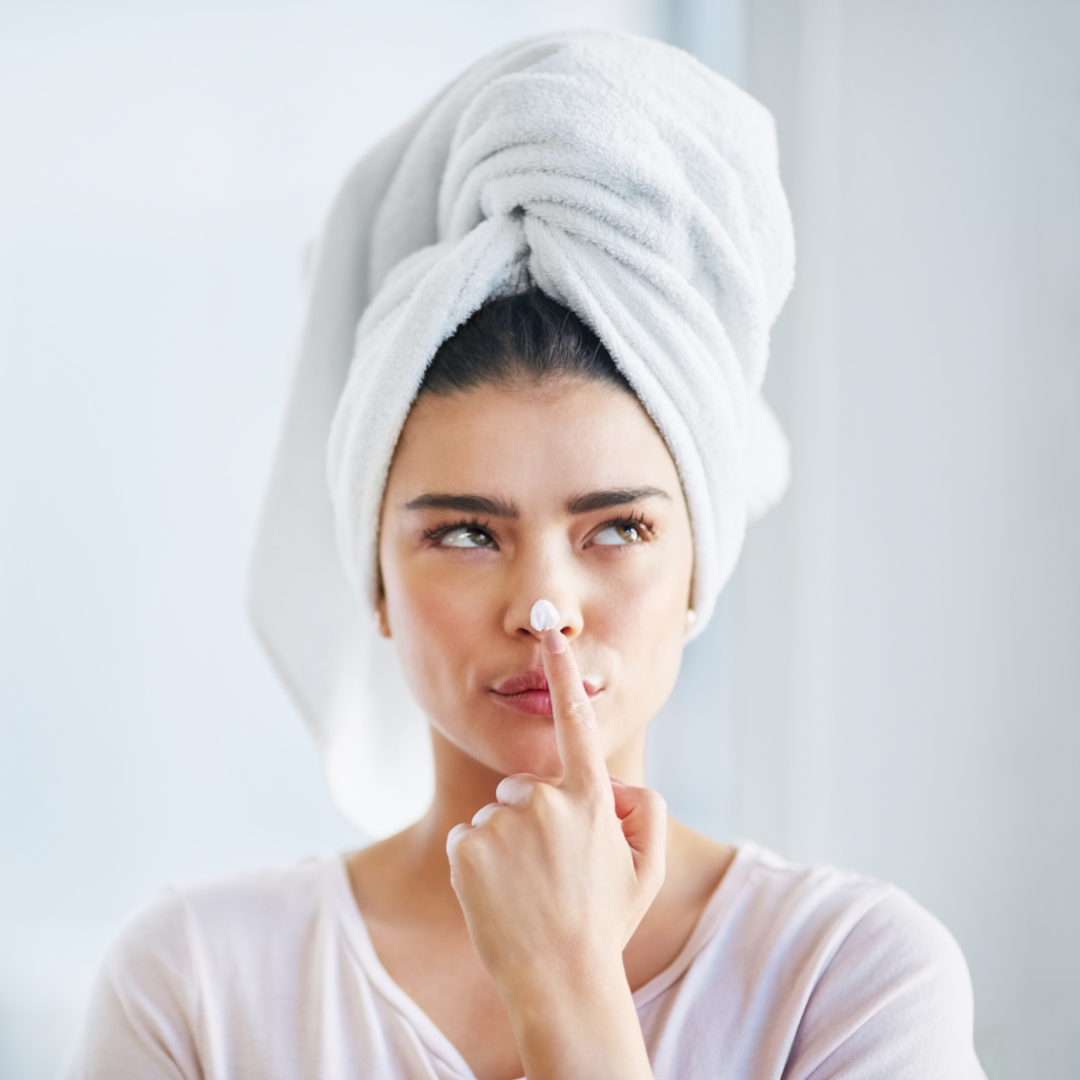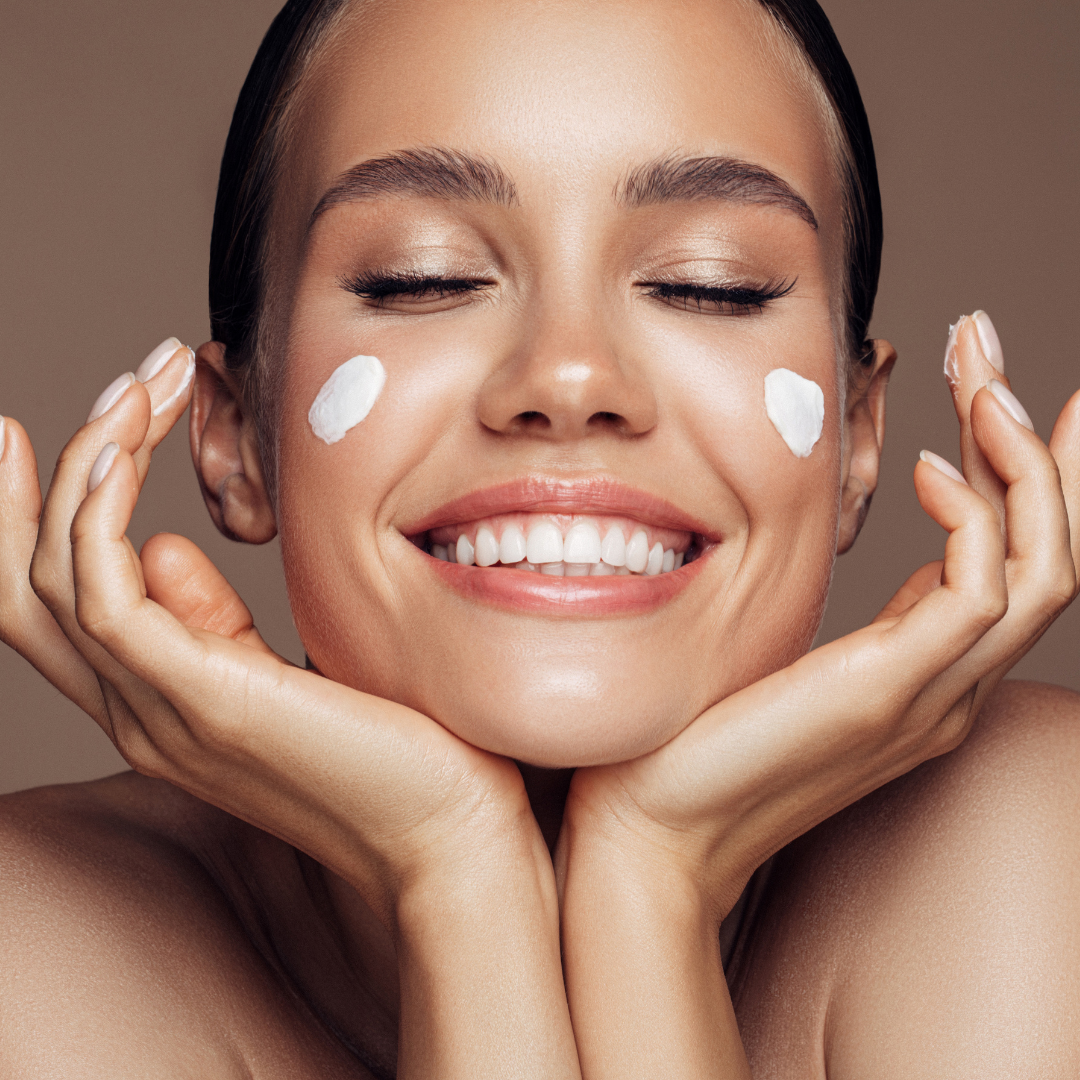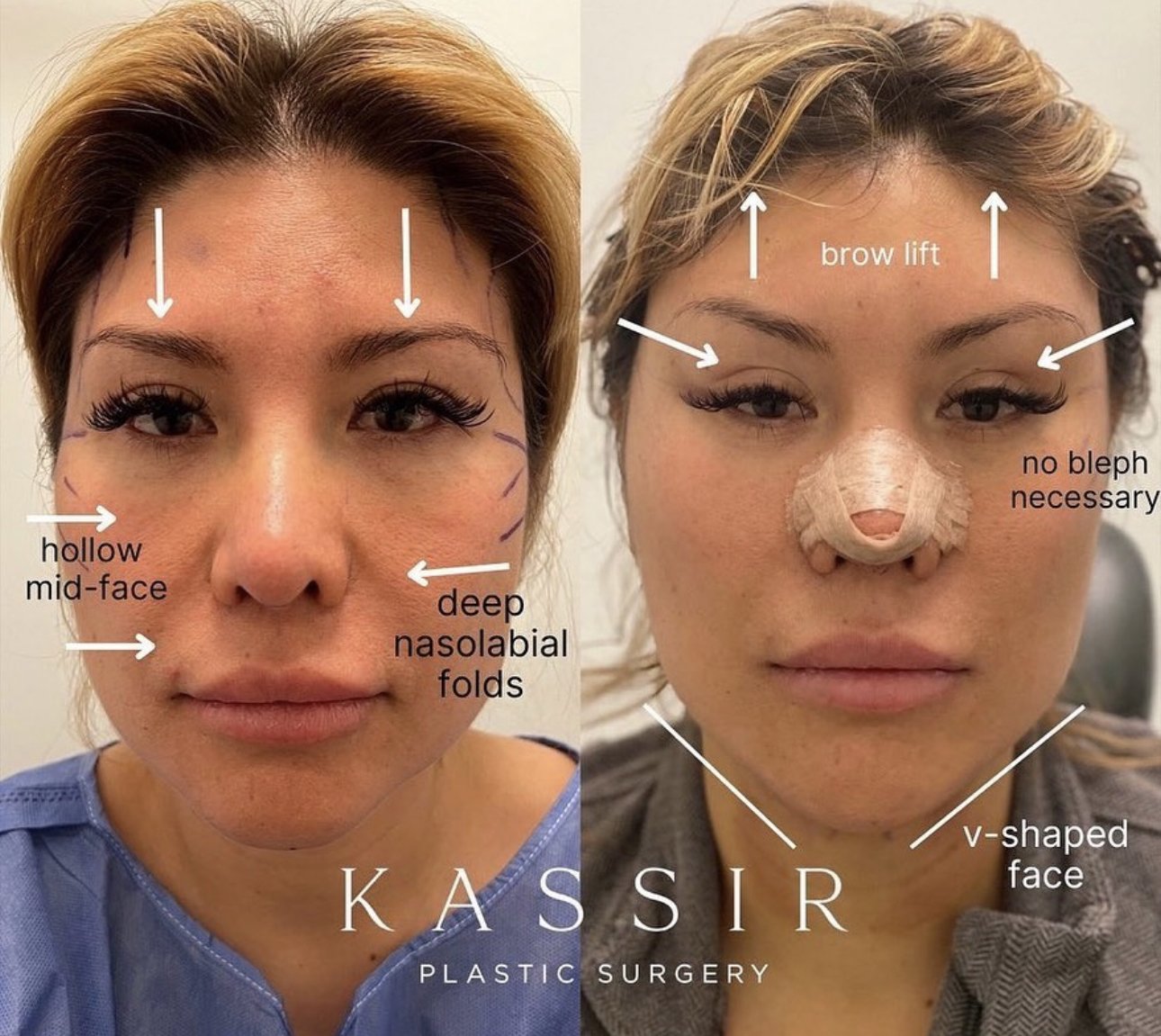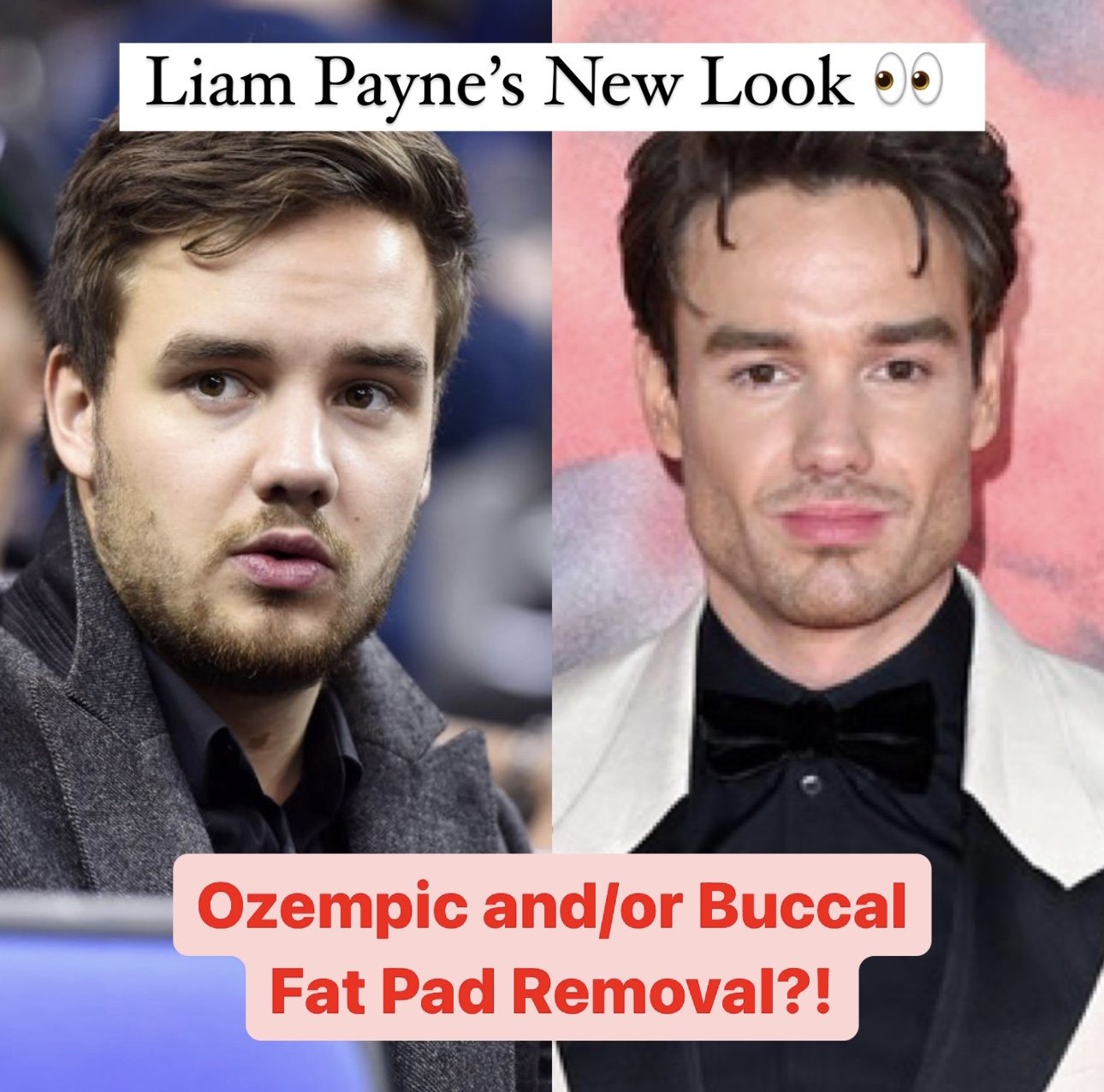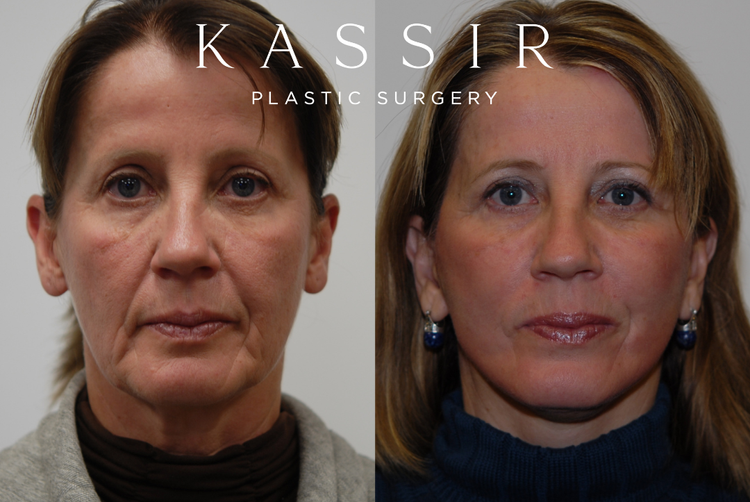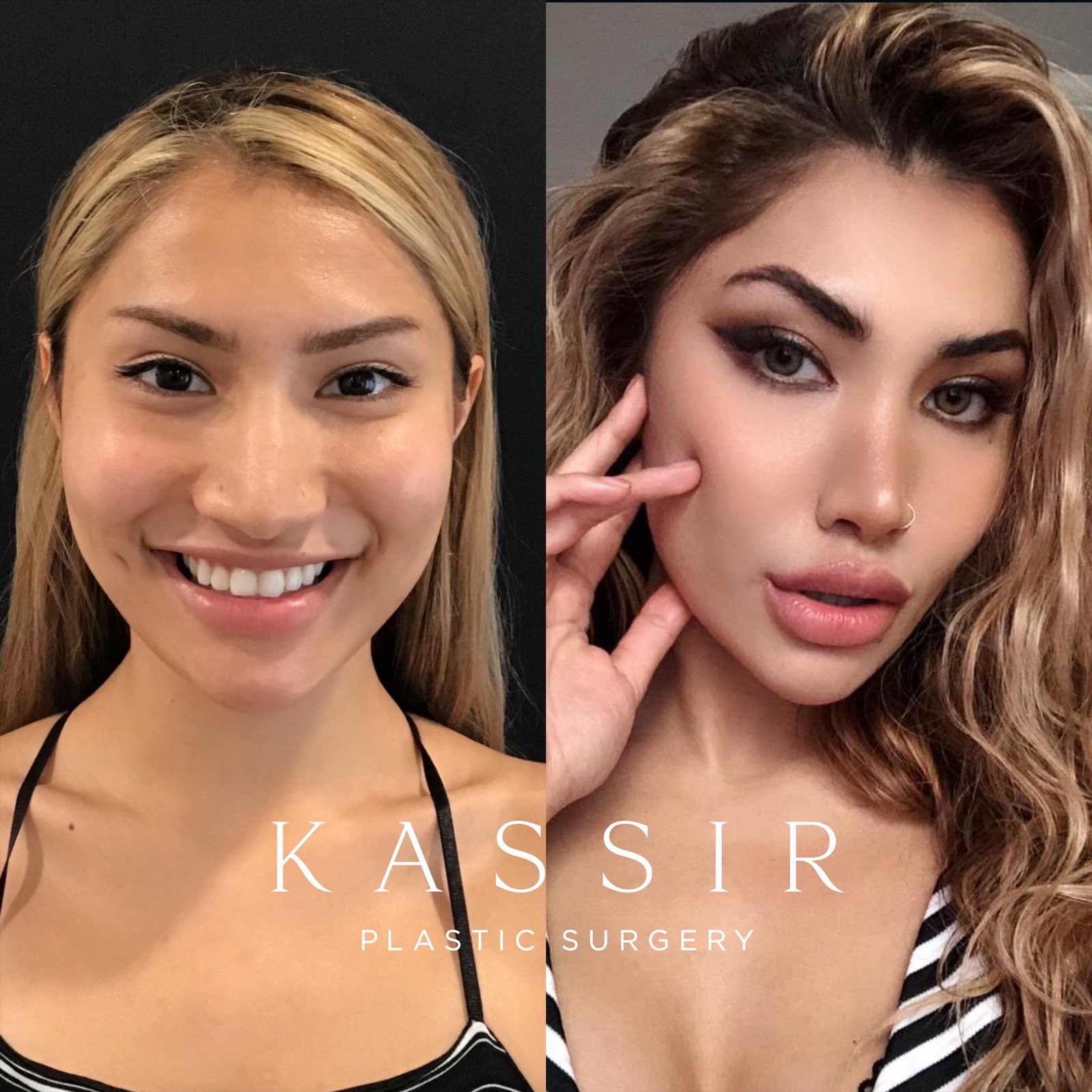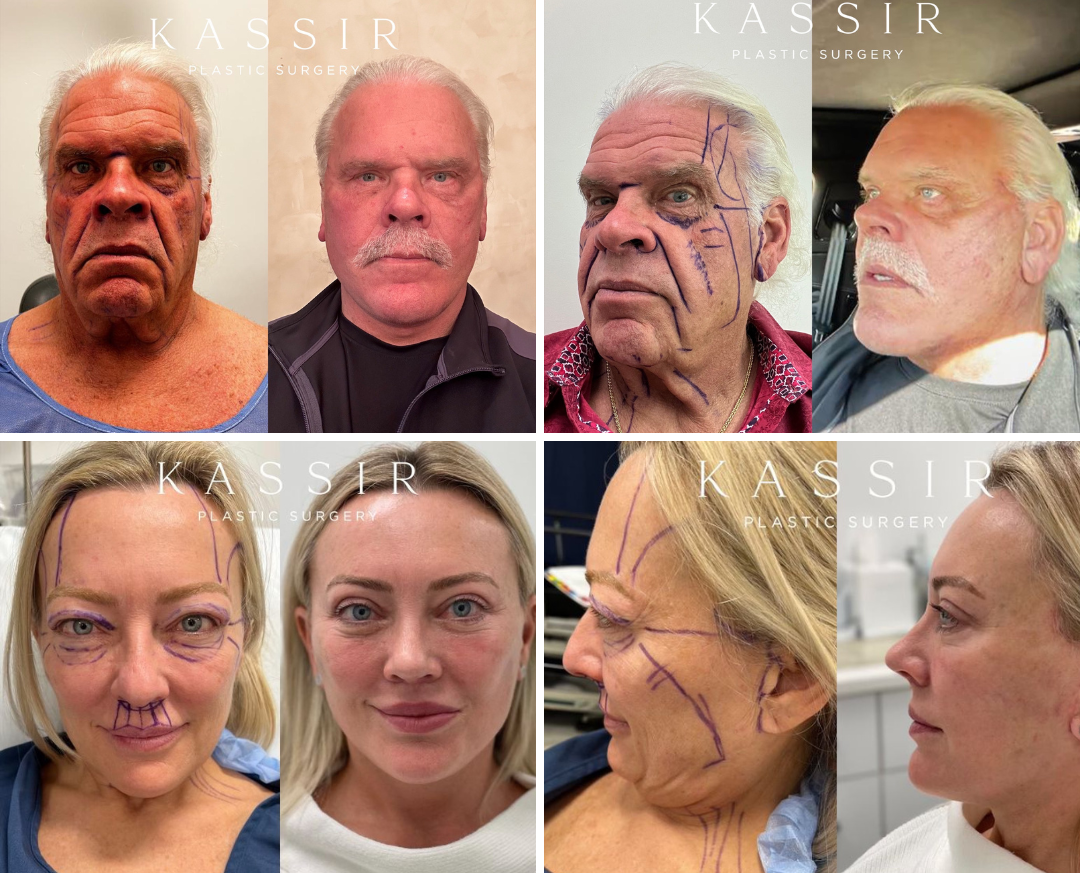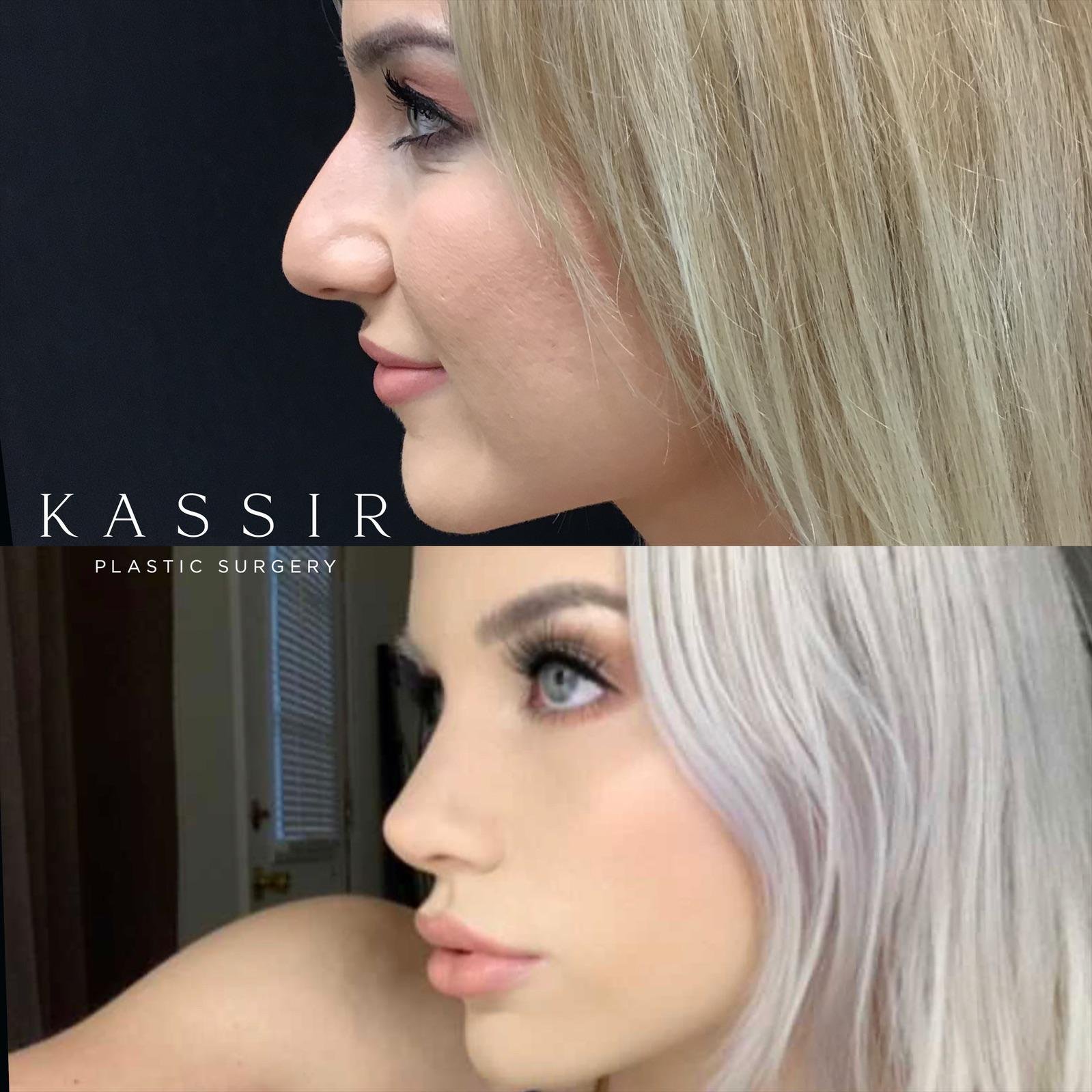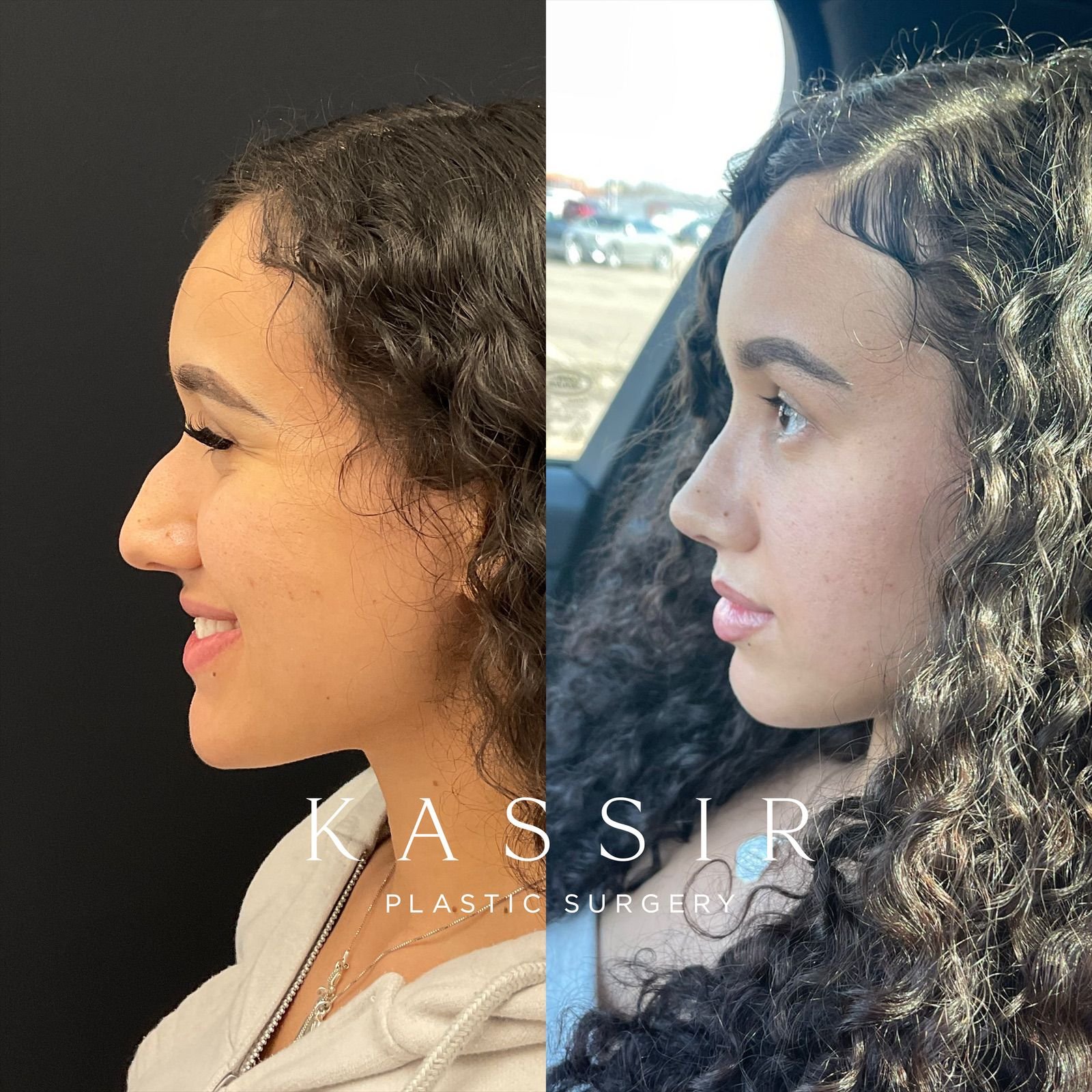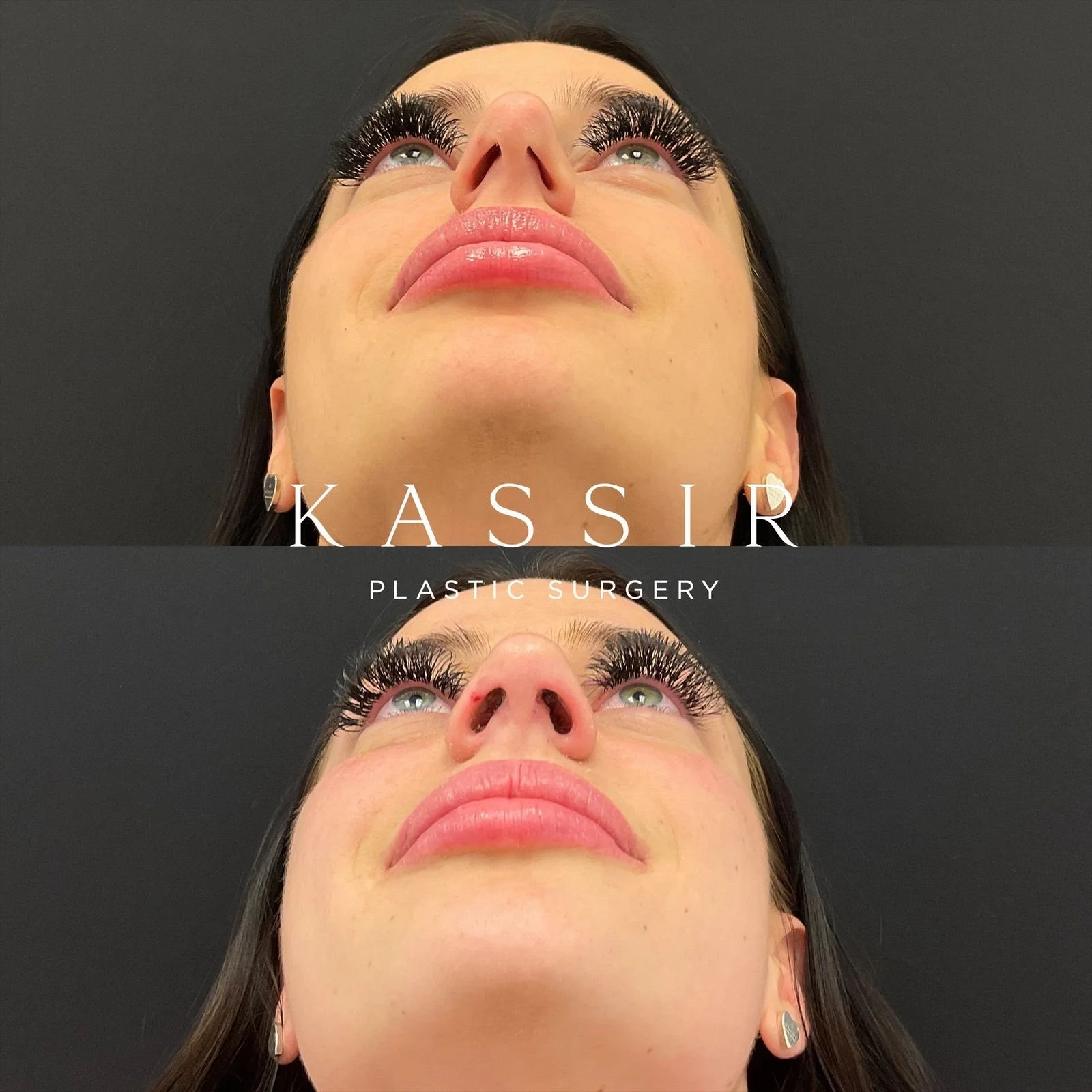The Benefits of Upper Blepharoplasty: Look More Awake and Improve Your Sight
Are drooping eyelids causing you vision problems or making you look constantly tired? Then you may want to consider getting an upper blepharoplasty. This surgical procedure removes excess skin and fat from the upper eyelids to give you a more refreshed, youthful appearance. In addition to aesthetic benefits, upper blepharoplasty also has functional benefits for older adults experiencing obstructed vision due to sagging eyelids. Let's explore the many benefits of upper blepharoplasty.
1. Look More Awake: Upper blepharoplasty can give you a rested, more youthful look by opening up your eyes and eliminating the saggy skin that can make you look tired. The procedure also removes puffiness and bags that develop over time, so that you look refreshed and more alert. These changes can have a tremendous impact on your self-confidence, especially if you've been conscious of your appearance. Not only does it rejuvenate your appearance, it can also help improve your mood by making you feel more confident and energized.
2. Improved Vision: In some patients, sagging of the upper eyelid skin can interfere with proper vision by obstructing the field of vision. Blepharoplasty can help correct this problem, allowing the patient to see more clearly and improve their overall quality of life. This is especially beneficial for older adults, whose vision may have already been affected by ageing-related issues.
3. Minimal Pain and Recovery Time: A major advantage of upper blepharoplasty compared to other cosmetic procedures is that it generally involves minimal discomfort and recovery time. Most patients are able to return to normal activities within 7-10 days following the surgery. This makes it an ideal solution for those who want to improve their appearance without having to take too much time off work or other commitments.
4. Long-Lasting Results: Generally speaking, the results from upper blepharoplasty are long-lasting and can last for years. This means not only will you look better immediately after the surgery, but the effects will continue to improve over time. As you age, your skin will sag again, but the extent to which it will do so after the procedure will be much less.
5. Customizable to Your Needs: Depending on the extent of your droopy eyelids and the look you're hoping to achieve, there are different types of blepharoplasty procedures available. Dr. Kassir can help you choose the best option for you, based on your eyelid shape and the amount of excess skin that needs to be removed.
If you're looking to improve your appearance and vision, it's worth considering upper blepharoplasty. Not only will it give you a more rested, youthful look, but also help improve your mood and self-confidence. Whether you're looking to lift up sagging eyelids or improve your ability to see properly, this procedure offers a wide range of benefits.
What to Look For in a Retinol Cream?
When looking for a retinol cream, there are several important factors to consider. Retinol is a derivative of vitamin A and is known for its potential benefits in promoting skin health, reducing the appearance of fine lines and wrinkles, and improving overall skin texture. Here are some key aspects to consider when selecting a retinol cream:
Concentration: Check the concentration of retinol in the cream. Retinol creams typically come in various strengths, ranging from 0.1% to 2%. It's generally recommended to start with a lower concentration and gradually increase it over time to minimize the risk of skin irritation. However, it's important to note that higher concentrations may not necessarily equate to better results.
Formulation: Pay attention to the overall formulation of the cream. Look for stable formulations that ensure the retinol remains active and effective. It's also beneficial to choose a product with additional ingredients that can enhance the moisturizing and nourishing properties of the cream, such as hyaluronic acid, peptides, or antioxidants.
Packaging: Retinol is sensitive to light and air, which can degrade its effectiveness. Opt for products that are packaged in opaque or airtight containers to protect the retinol from degradation and maintain its potency.
Product Reviews: Read reviews from other users to gain insights into the cream's effectiveness and potential side effects. Keep in mind that individual experiences may vary, but reviews can provide helpful information about the product's overall performance and user satisfaction.
Compatibility with Skin Type: Consider your skin type and any specific concerns you may have. Retinol creams can be beneficial for various skin types, but individuals with sensitive or dry skin may need to choose a milder formulation or use retinol products less frequently to avoid irritation.
Usage Instructions: Carefully follow the recommended usage instructions provided by the manufacturer. Retinol creams are typically applied at night, and it's important to start with a small amount and gradually increase usage as tolerated by your skin. Always use sunscreen during the day when using retinol, as it can increase skin sensitivity to the sun.
Price: Consider your budget when selecting a retinol cream. Higher-priced products don't always guarantee superior quality, so it's important to strike a balance between cost and effectiveness.
Should you Moisturize After Retinol?
Yes, moisturizing after using a retinol cream is generally recommended. Retinol can potentially cause dryness or irritation, especially when starting to use it or if you have dry or sensitive skin. Moisturizing helps replenish the skin's hydration and minimize any potential dryness or flakiness associated with retinol use.
Here are a few tips for moisturizing after applying retinol cream:
Wait for Absorption: Allow the retinol cream to absorb into your skin for a few minutes before applying moisturizer. This ensures that the retinol has had a chance to penetrate the skin and won't be diluted or disrupted by the moisturizer.
Choose a Suitable Moisturizer: Opt for a moisturizer that is gentle, nourishing, and suitable for your skin type. Look for moisturizers with hydrating ingredients like hyaluronic acid, ceramides, or glycerin. These ingredients help lock in moisture and restore the skin's barrier function.
Apply Moisturizer as Needed: Depending on your skin's needs, you may need to apply moisturizer once or twice a day. It's especially important to moisturize in the evening after using retinol, as this helps counteract any potential dryness or sensitivity that may occur overnight.
Layering Technique: If you prefer, you can apply a thin layer of moisturizer first and then follow with the retinol cream. This layering technique can help create a buffer between the retinol and your skin, reducing the risk of irritation while still allowing the retinol to be effective.
Sunscreen During the Day: When using retinol, it's crucial to protect your skin from the sun's harmful rays. During the daytime, apply a broad-spectrum sunscreen with at least SPF 30 after moisturizing. Retinol can increase skin sensitivity to the sun, so sunscreen helps prevent sunburn, sun damage, and other adverse effects.
Remember, everyone's skin is different, so it's important to find a moisturizing routine that works for you. If you have specific concerns or if you experience persistent dryness or irritation, it's advisable to consult with a dermatologist or skincare professional for personalized recommendations and guidance.
Are Retinol Creams Good for All Skin Types?
Retinol creams can be beneficial for many different skin types, but it's important to consider individual factors and adjust usage accordingly. Here's a general overview of how retinol creams can work for various skin types:
Normal to Dry Skin: Retinol creams can help improve skin texture, reduce the appearance of fine lines, and enhance overall skin tone and radiance. Individuals with normal to dry skin may need to pay extra attention to moisturization when using retinol, as it can potentially cause dryness or flakiness. It's recommended to choose a retinol cream with added moisturizing ingredients or to layer a hydrating moisturizer over the retinol to help counteract any potential dryness.
Oily and Acne-Prone Skin: Retinol creams can be particularly beneficial for individuals with oily or acne-prone skin. They help regulate sebum production, reduce the occurrence of clogged pores, and promote cell turnover, which can lead to clearer and smoother skin. However, it's important to start with a lower concentration and gradually increase usage to minimize the risk of excessive dryness or irritation. Consistent use of sunscreen is crucial when using retinol to avoid increased sensitivity to the sun.
Sensitive Skin: Individuals with sensitive skin may need to exercise caution when using retinol. While retinol can be effective for sensitive skin, it's essential to choose a milder formulation and introduce it gradually into the skincare routine. Starting with a lower concentration and using retinol products less frequently can help minimize the risk of skin irritation. It's advisable to patch test a small area of skin before applying retinol to the entire face. Additionally, using a gentle and hydrating moisturizer alongside retinol can help mitigate potential sensitivity.
Combination Skin: Retinol creams can work well for combination skin, which typically exhibits a mix of dry and oily areas. The exfoliating and skin-renewing properties of retinol can help balance out the skin's texture and reduce the appearance of fine lines, while also addressing any oiliness or acne concerns. It's important to monitor how the skin responds to retinol and adjust usage accordingly in different areas of the face.
Remember, individual responses to retinol can vary, so it's crucial to listen to your skin and adjust usage based on its needs. If you have specific skin concerns or conditions, it's advisable to consult with a dermatologist or skincare professional who can provide personalized recommendations and guidance on incorporating retinol into your skincare routine.
What are the Benefits of Retinol Creams?
Retinol creams offer several benefits for the skin. Here are some of the key advantages of using retinol:
Reduction of Fine Lines and Wrinkles: Retinol is renowned for its ability to minimize the appearance of fine lines and wrinkles. It stimulates collagen production in the skin, which helps improve skin elasticity and firmness. With regular use, retinol can soften the appearance of wrinkles, fine lines, and crow's feet, resulting in a smoother and more youthful complexion.
Improved Skin Texture: Retinol promotes cell turnover and exfoliation, which can lead to improved skin texture. By shedding dead skin cells and encouraging the growth of new skin cells, retinol helps refine the skin's surface, making it smoother, brighter, and more even-toned. It can also reduce the appearance of rough patches, acne scars, and other textural irregularities.
Enhanced Skin Radiance: Retinol helps boost cellular renewal and blood circulation in the skin, resulting in a more radiant complexion. It can help fade dullness and promote a healthier, glowing appearance.
Reduction of Hyperpigmentation: Retinol has the potential to fade dark spots, sunspots, and other forms of hyperpigmentation. It works by inhibiting the production of melanin, the pigment responsible for dark spots. With consistent use, retinol can help even out skin tone and diminish the visibility of pigmentation irregularities.
Prevention and Treatment of Acne: Retinol can be effective in managing acne-prone skin. It helps regulate oil production, prevent clogged pores, and reduce inflammation associated with acne breakouts. By keeping the pores clear and promoting healthier skin turnover, retinol can help minimize the occurrence of acne and improve the overall condition of the skin.
Antioxidant Protection: Retinol possesses antioxidant properties, which means it can help neutralize free radicals and protect the skin from oxidative stress caused by environmental factors like pollution and UV radiation. This antioxidant effect can help prevent premature aging and maintain skin health.
It's important to note that the results of using retinol may vary depending on individual skin characteristics, the specific product formulation, and consistency of use. It's advisable to introduce retinol gradually into your skincare routine and to use it in conjunction with sunscreen during the day, as retinol can increase skin sensitivity to the sun.
What Concentration of Retinol is Best?
The best concentration of retinol in a cream depends on various factors, including your skin type, tolerance, and the specific concerns you want to address. Retinol creams typically range in concentration from 0.1% to 2%. Here's a general guideline for choosing a suitable retinol concentration:
Beginners and Sensitive Skin: If you're new to using retinol or have sensitive skin, it's generally recommended to start with a lower concentration, such as 0.1% or 0.3%. This allows your skin to acclimate to the retinol and minimizes the risk of irritation. Starting with a milder concentration also allows you to gauge your skin's response and gradually increase the concentration over time.
Normal or Combination Skin: If your skin tolerates retinol well and you have normal or combination skin, you can consider using a slightly higher concentration, such as 0.5% or 0.6%. These concentrations provide a balance between effectiveness and potential side effects.
Resistant Skin or Advanced Users: Individuals with more resilient skin or those who have been using retinol for a while may opt for higher concentrations, such as 1% or 2%. These higher concentrations can provide more significant results but should be used with caution to avoid excessive irritation or dryness. It's important to closely monitor your skin's response and adjust usage accordingly.
Remember, the concentration of retinol is not the sole determinant of effectiveness. Factors like formulation, stability, and overall product quality also play a significant role. Some retinol creams may incorporate additional ingredients or technologies that enhance the effectiveness and tolerability of the product.
How do Retinol Creams Work?
Retinol creams work by delivering retinol, a derivative of vitamin A, to the skin. Once applied topically, retinol undergoes a conversion process in the skin, where it is converted into retinoic acid. Retinoic acid is the active form that interacts with skin cells and triggers various biological processes.
Here's how retinol creams work:
Stimulation of Collagen Production: Retinol stimulates the production of collagen, a protein that provides structure and elasticity to the skin. Collagen production tends to decline with age, leading to the formation of wrinkles and fine lines. By promoting collagen synthesis, retinol helps improve skin firmness and reduce the appearance of wrinkles.
Acceleration of Skin Cell Turnover: Retinol increases the rate at which skin cells are produced and shed. It enhances the process of exfoliation, removing dead skin cells from the surface and allowing new, healthier cells to emerge. This can lead to smoother, more even-toned skin and a reduction in the appearance of rough patches or discoloration.
Stimulation of Blood Vessels: Retinol can promote the dilation of blood vessels in the skin, increasing blood flow and improving overall skin health. Enhanced blood circulation helps deliver oxygen and nutrients to the skin cells, resulting in a more radiant and revitalized complexion.
Regulation of Oil Production: Retinol has the potential to regulate oil production in the skin. It can help normalize sebum production, making it beneficial for individuals with oily or acne-prone skin. By reducing excess oiliness, retinol can help prevent clogged pores and reduce the occurrence of acne breakouts.
Antioxidant Properties: Retinol has antioxidant properties, which means it helps neutralize harmful free radicals that can cause damage to the skin. By protecting the skin against oxidative stress, retinol can help prevent premature aging and maintain a youthful appearance.
It's important to note that retinol can cause skin sensitivity, especially when first starting to use it. Some individuals may experience temporary redness, dryness, or mild irritation. It's recommended to introduce retinol gradually into your skincare routine, starting with a lower concentration and increasing usage over time to allow your skin to adjust.
Additionally, it's crucial to use sunscreen during the day when using retinol, as it can increase skin sensitivity to the sun. Regular use of retinol creams, along with proper sun protection and a consistent skincare routine, can help achieve improved skin texture, reduced signs of aging, and a more youthful complexion
Scarless Face & Brow Lift
As we age, our skin loses elasticity and tends to sag. While this is a natural process, it can affect our self-confidence and make us look older than we feel. Traditional face and brow lifts require large incisions and extended recovery times, which can be inconvenient and uncomfortable for many people. Fortunately, the "One Stitch Lift™" is a scarless, minimally invasive procedure that can produce stunning results with minimal downtime and discomfort.
What is "One Stitch Lift™"?
Dr. Kassir utilizes a technique where he makes an incision in the temporal hair and dissect in a sub galeal plane, release the orbital ligament, dissect under the Malar fat pad and midface, and Lift the entire midface, brows, and lower face. It creates an aesthetic and youthful, v -shaped jawline, corrects jowling and rejuvenates the face and lifts the brows. If the patient so desires they can contour their brows into “fox eye” or “cat eyes” The benefits are that you don’t need incisions around the ears and the dissection is done endoscopically with minimal bruising and downtime.
Benefits of "One Stitch Lift™":
The "One Stitch Lift™" offers many benefits over traditional facelifts. Firstly, the procedure requires only a single stitch, which means no visible scarring or unsightly incisions around the ears. Secondly, recovery time is much faster - most patients can return to work or other activities within a few days of the procedure. And unlike traditional facelifts, which can produce an unnatural over-pulled look, the "One Stitch Lift™" produces a natural-looking lift that enhances the contours and features of the face.
Who is a good candidate for "One Stitch Lift™"?
Most people who are concerned about sagging skin around the face and brow are good candidates for the "One Stitch Lift™". This procedure is particularly suitable for patients who have mild to moderate sagging, and who want a quick, minimally invasive solution. It's also ideal for those who want to avoid the risks and complications associated with surgery, or who simply fear the prospect of extensive downtime and recovery.
If you're considering facial rejuvenation but are hesitant to undergo a traditional facelift, the "One Stitch Lift™" may be the perfect solution for you. This innovative procedure can produce stunning results with minimal discomfort, downtime, and scarring. And with its natural-looking lift and contour enhancement, you'll be able to enjoy a more youthful, revitalized appearance that will boost your confidence and self-esteem.
Male Lift NYC
Lip lifts are becoming increasingly popular cosmetic procedures for women, but did you know that men can also benefit from this procedure? A male lip lift is a surgical procedure designed to make lips look fuller and more youthful. This blog post will explore the differences between a male lip lift and one for women, as well as who makes a good candidate for such a procedure.
Differences between Male and Female Lip Lifts
Male and female lip lifts differ in several ways. First, the incision placement for male lip lifts is slightly different than that of female lip lifts. Men typically have heavier skin on their upper lips which means that the incision is placed higher up on their upper lips than it would be for women. The result of this difference in placement is that males tend to get more pronounced results from their lip lifts than females do. Additionally, men often require more volume-enhancing procedures such as dermal fillers to achieve maximum results from their lip lifts while women may not need any additional help in this area.
Who Is a Good Candidate For a Male Lip Lift?
Not everyone is an ideal candidate for a male lip lift procedure. Generally speaking, those who are 40 years or older are better suited for this procedure since aging causes the lips to lose fullness and definition over time. Furthermore, males with thinning or sagging upper lips may be better suited for a male lip lift since it can help create a fuller upper lip with greater definition. Finally, those who have lost volume in the midface due to aging may also find that they benefit from getting a male lip lift since it helps restore some of that lost volume and youthfulness to their face.
A male lip lift can be an excellent way for men to restore fullness and youthful definition to their lips as they age—but only if they’re good candidates for the procedure. Men who are 40 years or older with thinning or sagging upper lips may find that they benefit significantly from getting a male lip lift done by an experienced plastic surgeon or dermatologist. If you think you might be an ideal candidate for this type of procedure, consult with your doctor today to learn more about how it could help improve your appearance!
Lip Lifts for Men NYC
A lip lift is an increasingly popular procedure that can help enhance the look of your lips, especially if you feel like the area around your cupid’s bow has a lack of definition and contour. With the expertise of top plastic surgeon Dr. Kassir, located in New York City and New Jersey, this transformation can be achieved within one hour. While lip lifts are typically associated with women, men too can benefit from the procedure to get rid of thin lips, increase tooth show, and enjoy more fullness and redness on their lips - all helping them to feel more confident when they smile.
What is a Lip Lift?
A lip lift is a surgical procedure that changes the shape of your upper lip by removing excess tissue from either or both sides of it. This creates a more aesthetically pleasing look featuring increased tooth show and curvature at the cupid’s bow. The surgery takes about an hour and is performed under local anesthesia. It generally uses dissolvable sutures for a quick recovery period with minimal discomfort or downtime afterward.
Why Choose Dr. Kassir?
Dr. Kassir has been performing facial procedures such as rhinoplasty, facelift surgery, neck lifts, eyelid surgery, brow lifts, chin augmentation/re-contouring for 26 years - making him one of the most experienced surgeons in his field. He has performed thousands of successful procedures over the years while maintaining his commitment to excellent patient care and beautiful results. When it comes to lip lifts specifically, he understands how important it is for patients to achieve natural looking results that do not draw too much attention but still make them happy with their appearance when they look in the mirror each morning. That’s why he works closely with each patient to understand their individual goals before crafting a tailored treatment plan specific to them – ensuring they receive optimal results that meet their satisfaction every time!
A lip lift can be a great way for both men and women alike to enhance their appearance without undergoing extensive or invasive cosmetic surgery. With Dr. Kassir’s expertise in this field combined with his commitment to excellent patient care and positive results - you can rest assured knowing you will receive natural-looking results that make you feel confident when you smile! If you are considering getting a lip lift procedure done soon - contact our office at 212-288-3000 today for more information! You won’t regret it!
The Latest Cosmetic Craze: Buccal Fat Pad Removal
Liam Payne’s New Look
For years, celebrities have been turning to cosmetic procedures to enhance their looks. But there’s a new craze that is taking Hollywood by storm and it’s called buccal fat pad removal. This procedure involves the removal of fat pads located in the cheeks and promises to give you a more sculpted and chiseled face. So what’s all the fuss about? Let’s take a closer look at buccal fat pad removal and how it can affect your look.
What Is Buccal Fat Pad Removal?
Buccal fat pad removal is a minimally invasive surgical procedure that removes the natural cushioning from your cheeks. In some cases, this fat padding can make one’s face appear fuller than is desired. Thus, by removing this excess facial fat, buccal fat pad removal can help create a more angular, chiseled look for the patient.
The Procedure
Buccal fat pad removal is typically done as an outpatient procedure with local anesthesia. A small incision will be made inside of the mouth in order to access the cheek area where the excess facial fat resides. The surgeon will then carefully remove the desired amount of facial fat while preserving any essential tissue or muscles in the area. Once removed, this tissue is then discarded, leaving behind a more defined and angular face shape for the patient to enjoy.
Recovery Process
The recovery process for buccal fat pad removal typically takes between 1-2 weeks depending on individual healing rates and post-operative care instructions followed by patients. During this time period, patients should avoid strenuous physical activity as well as contact sports and other activities that could cause further injury or complications during their recovery period. Patients may also experience some swelling or bruising around their cheeks which should subside after several days or weeks depending on individual healing rates and post-operative care instructions followed by patients following surgery.
Conclusion:
Buccal fat pad removal has become an increasingly popular cosmetic procedure among celebrities looking to achieve a more chiseled look for their faces without undergoing extensive plastic surgery procedures like facelifts or chin implants/jawline augmentations (which are much more invasive).
Liam Payne recently unveiled his new look which many speculate was achieved through buccal fat pad removal, weight loss medication Ozempic, cheekbone filler injections, or even jawline fillers--or perhaps even all four! No matter how he achieved his newly sculpted face shape, however, it's clear that buccal fat pad removal is definitely here to stay in Hollywood circles!
Ever Wondered What Facelift Before and Afters look like?
A facelift is a cosmetic procedure designed to improve the appearance of facial wrinkles and loose or sagging skin. The procedure can be customized depending on the patient’s individual needs, from a full-face lift to smaller areas such as the jawline, neck, and forehead. It requires an experienced facial plastic surgeon to reliably achieve desired results.
To understand the transition between a facelift before and after, it is important to understand how the procedure and recovery work. Healing after a facelift procedure can be broken down into three stages. Immediately following the procedure, you may experience some swelling and bruising in the areas that have been treated. This will typically last for several days to a week, although this time period may vary from person to person. During this initial stage, it is important to keep the area clean and dry, so you may need to wear a bandage or other protective covering for a few days.
Once the swelling and bruising have gone down, you will begin to see some of the initial results of your facelift procedure. Wait you want to see what it actually looks like?
Before we take a look at before and afters - What exactly is a facelift?
A facelift, often combined with a neck lift, is a surgical procedure that can help to improve the appearance of wrinkles and sagging skin on the face, neck, jawline and forehead. The overall goal is to achieve facial rejuvenation by addressing excess skin, excess neck skin, facial laxity, and overall tissue descent. Different techniques can be used to achieve different results depending on each individual’s needs. All facelift and neck lift procedures are performed under general anesthesia and involve making small incisions in the scalp or around the ears.
Now, let’s look at some before and after photos of people who have undergone a facelift procedure.
Before and After Photos Facelift
You can see that these patients have had sagging skin, wrinkles, and jowls prior to the surgery. After the procedure, their faces appear tighter, smoother and more youthful-looking. Very often facelift procedure is combined with other surgeries to achieve the best possible facial rejuvenation. Many patients undergo simultaneous eyelid surgery, brow lift, fat injections, lip lift, and rhinoplasty.
But there is more to consider! Facelift before and after results will also depend a lot on the technique used.
Different Types of Facelifts (Mini-Facelifts, Full Facelifts, etc.)
At Kassir Plastic Surgery, triple board-certified Facial Plastic Surgeon Dr. Ramtin Kassir specializes in several different types of facelift procedures to help you achieve a more youthful-looking appearance. All facelift techniques will address excess skin, drooping jowls, and deep nasolabial folds.
A mini-facelift is an excellent option for those who want to minimize wrinkles or sagging skin around the lower face and neck without having a full surgical procedure. This type of procedure typically involves shorter incisions and less downtime for recovery.
Full facelifts, also often called SMAS facelift, on the other hand, are a more invasive procedure that typically involves making larger incisions around the ears. This type of surgery is designed to address wrinkles or sagging skin on the face, neck, jawline and forehead in order to create a more youthful appearance.
Deep Plane facelifts are a more advanced procedure involving lifting both the skin and underlying SMAS layer to provide long-lasting, natural-looking results. The SMAS layer is the connective tissue and muscle layer that lies beneath the skin and is responsible for keeping your face firm and lifted. In addition, several bands attach the SMAS to your bone. Those tend to get loose with aging and restrict the lifting of the face if not released properly. In a deep plane facelift these adhesive bands are free to allow a long-lasting and rejuvenating lift of your face.
Let's take a look at some Deep Plane Facelift before and Afters
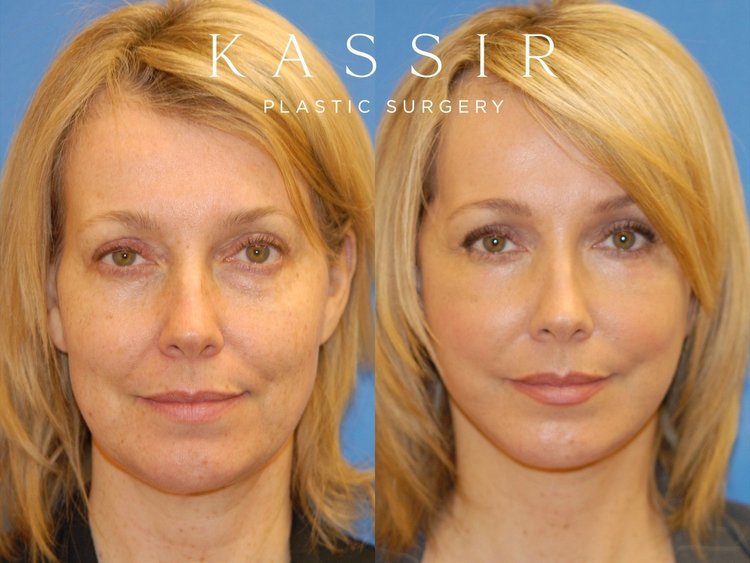

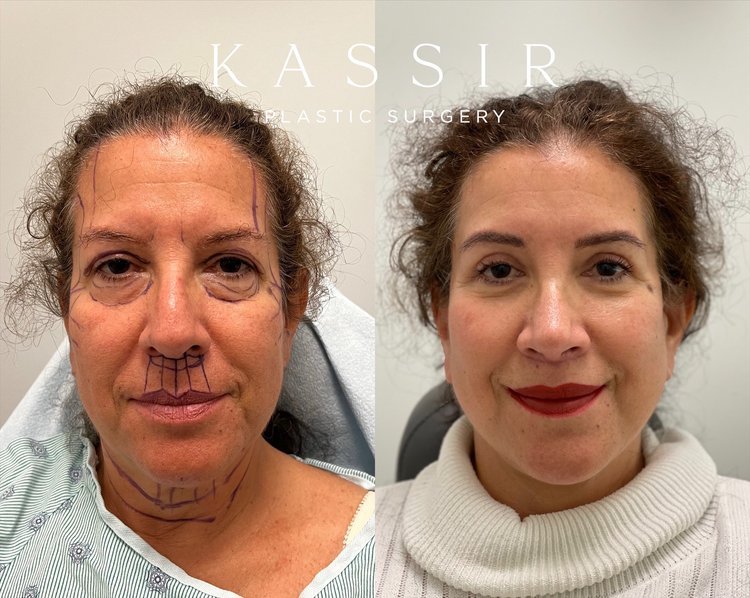
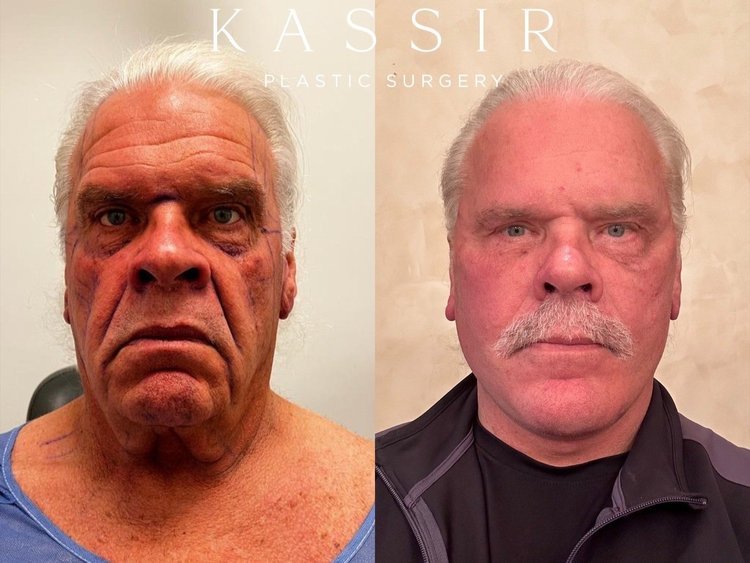
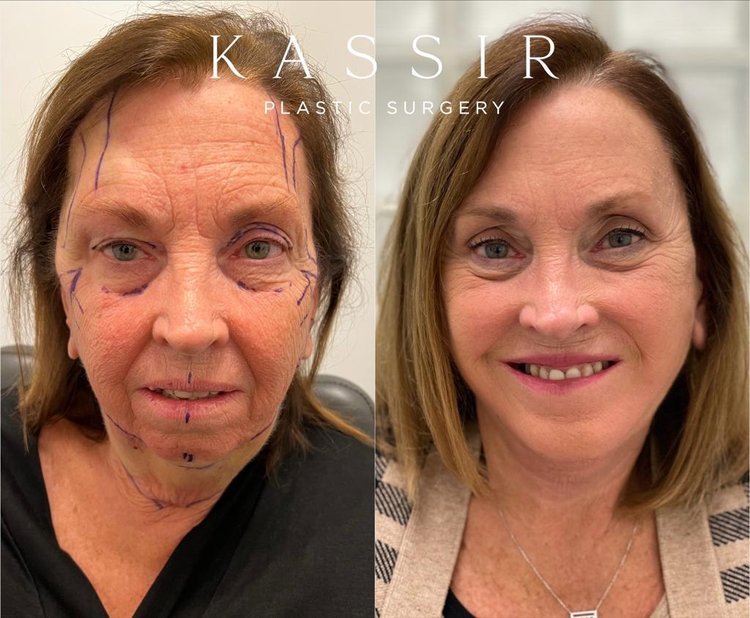
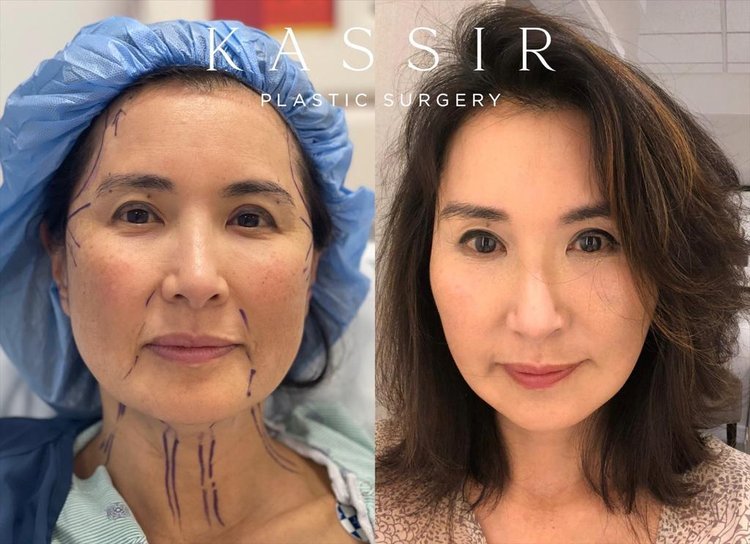
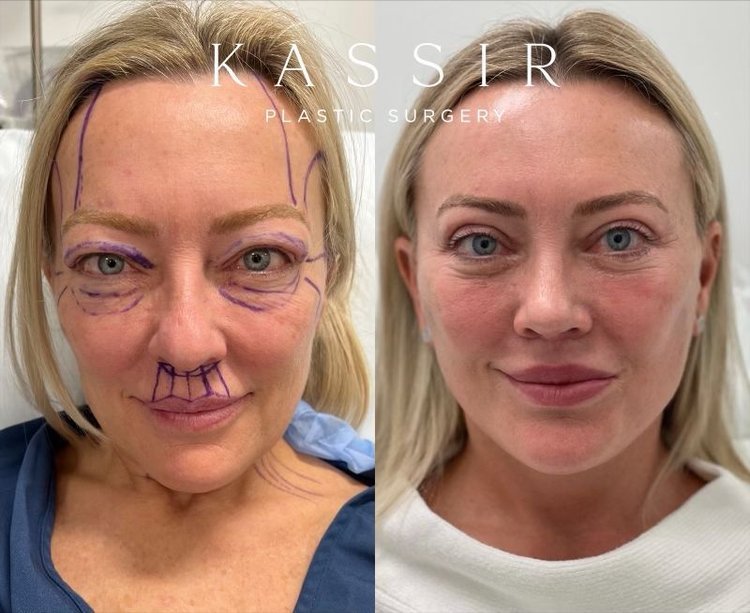
Often combined procedures with a facelift
Recovery After a Facelift
Recovery time for a facelift procedure will vary depending on the type of surgery and the individual patient. Generally, you can expect some swelling and bruising around the face and neck in the weeks following surgery but these should gradually decrease over time. If you had additional facial procedures these areas might swell as well such as the lower eyelids. It is important to keep your head elevated and avoid strenuous activity during this period. Luckily facial swelling improves quickly.
Recovery Timeline and Tips
Day 2-5: You will experience moderate swelling and bruising around the face and neck in these early stages. Be sure to keep your head elevated and avoid strenuous activity for the first few days.
Days 5-12: Swelling should begin to diminish during this period, but you may still need to wear a bandage or compression garment to help reduce bruising.
Day 12-15: Most swelling should have subsided and you can start to resume normal activities. Make sure to take it easy in the first few weeks following your procedure.
Weeks to months: Your initial tension will settle and relax achieving natural results.
Healing Stages immediately after facelift in a 64 year old
If you want to tackle facial aging at any age, contact us today. Facelift is not only reserved for cosmetic surgery but can also be applied for reconstructive surgery. Dr. Kassir and his plastic surgeons will develop the best plan for you, including all surgical and non-surgical options. With our facelift before and after gallery you will have a great idea what to expect.
How much does a Rhinoplasty cost?
The cost of rhinoplasty can vary widely depending on a number of factors, including the complexity of the procedure, the experience and qualifications of the surgeon, and the location of the practice. On average, the cost of rhinoplasty can range from $15,000 to $50,000, although it can be higher or lower depending on the specific needs of the patient.
Some other factors that can affect the cost of rhinoplasty include:
Anesthesiologist fees: Many rhinoplasty procedures are performed under general anesthesia, which requires the services of an anesthesiologist. The cost of the anesthesiologist's services will be added to the overall cost of the procedure.
Facility fees: If the procedure is performed in a hospital or surgery center, there may be additional fees for the use of the facility.
Post-operative care: The cost of post-operative care, such as follow-up visits and any necessary medications, will also be factored into the overall cost of the procedure.
Insurance coverage: Some health insurance plans may cover part or all of the cost of rhinoplasty if it is deemed medically necessary. It is important to check with your insurance provider to determine if your policy covers the procedure.
It is important to keep in mind that the cost of rhinoplasty should not be the only factor in your decision to undergo the procedure. It is important to choose a qualified and experienced surgeon, even if it means paying a little more.
Male Facelift before and after: What is the difference between men and women when it comes to facelift surgery.
When looking at before and after male facelifts and female facelifts you will notice distinct differences. Facelift surgery can benefit both men and women who are concerned about signs of aging in their face and neck. However, there are some important considerations that may differ based on the patient's gender. Here are a few factors to keep in mind:
Facial anatomy: Men and women have different facial structures, including bone structure and muscle mass, which can affect the approach to facelift surgery. For example, men typically have a stronger jawline and larger neck muscles, which may require a different surgical technique to achieve the desired results.
Hairline and sideburns: In male patients, it is important to preserve the natural hairline and sideburns, which can be more difficult to hide with short haircuts. The surgeon must be careful not to raise the hairline or distort the sideburns, which could create an unnatural appearance.
Skin thickness: Men tend to have thicker, oilier skin than women, which may require a different approach to facelift surgery. A skilled surgeon will take into account the patient's skin type and adjust the technique accordingly.
Goals and expectations: Men and women may have different goals and expectations for facelift surgery. Men may be more focused on creating a strong, masculine appearance, while women may want to achieve a softer, more feminine look. It is important for the surgeon to understand the patient's individual goals and tailor the surgery accordingly.
Recovery time: Recovery from facelift surgery can take several weeks, and men may need to take extra precautions to avoid strenuous activities that could cause bleeding or swelling. It is important to follow the surgeon's instructions carefully to ensure a smooth recovery.
In summary, while the principles of facelift surgery are similar for both men and women, the surgeon must take into account the patient's individual anatomy, skin type, and goals to achieve the best possible results which can be seen in before and after male facelift results.
What is Buccal Fat Pad Surgery and what does it look like before and after?
Buccal fat pad removal, also known as buccal lipectomy, is a facial cosmetic surgical procedure used to reduce the amount of fatty tissue in the cheek area. This procedure can help to create a more aesthetically pleasing facial contour and restore balance to the face by reducing fullness or puffiness in the cheeks. With a buccal fat removal procedure, excess fat from the buccal area is removed and the contour of the cheeks is altered to create a slimmer look.
The buccal fat pad is a naturally occurring fatty tissue found in your cheek area and part of the overall cheek fat pads. It has different functions, such as supporting the lower part of the eyes and providing a cushioning effect to the facial muscles. However, some people may have an excessive amount of buccal fat, making their cheeks appear round and puffy.
Buccal fat pad removal is a relatively safe procedure with few risks or complications. In some cases it can help reduce the appearance of chubby cheeks or jowls, as well as lines that develop near the mouth due to excess fatty deposits in this area. It can also be used to correct the effects of aging on the face such as sagging cheeks and jowls by removing pockets of tissue that have begun to droop with age.
This type of surgery is typically performed under local anesthesia and requires only a minimal incision made inside each cheek to access the buccal fat pad. The procedure is relatively quick and typically takes 45 minutes to 1 hour. After the surgery, patients can expect some swelling and bruising, which generally resolves within a few days. In most cases, patients can resume their normal activities after 1-2 days of rest.
The results of buccal fat pad surgery are long lasting and provide natural looking improvement to facial contours with minimal downtime. While it is not a substitute for weight loss or dieting, this procedure can help create a more toned facial appearance by reducing fatty deposits in the cheeks. It is important to note that everyone’s face structure is different—so it is wise to consult a qualified professional for personalized advice before undergoing any facial cosmetic procedure.
Overall, buccal fat pad surgery is a safe and effective way to reshape the cheeks and enhance facial contours. With the right surgeon and appropriate aftercare, patients can achieve long-lasting results with minimal downtime or adverse side effects. If you are considering this type of procedure, it is best to speak with your doctor about your individual needs and concerns for optimal outcomes.
Rhinoplasty cost NJ
The cost of rhinoplasty in New Jersey can vary widely depending on the specific needs of the patient, the complexity of the procedure, and the experience and qualifications of the surgeon. On average, the cost of rhinoplasty in New Jersey can range from $15,000 to $50,000 although it can be higher or lower depending on the specific circumstances of the case.
It is important to keep in mind that the cost of rhinoplasty should not be the only factor in your decision to undergo the procedure. It is important to choose a qualified and experienced surgeon, even if it means paying a little more.
It is also important to consider the other costs that may be involved in the procedure, such as the fees for the anesthesiologist, the facility where the procedure is performed, and any post-operative care that may be required.
It is always a good idea to discuss the costs of the procedure in detail with your surgeon before making a decision. Many plastic surgeons offer financing options or accept payment by credit card, which can make the procedure more affordable.
What is Female Feminization Surgery?
Female feminization surgery is a group of surgical procedures that aim to alter a person's physical appearance to align more closely with traditional societal expectations of femininity. These procedures can include breast augmentation, facial feminization, and genital reconstruction.
The decision to undergo female feminization surgery is a deeply personal one, and there are many factors that may influence a person's decision to pursue these procedures. For some, the surgery may be a means of aligning their physical appearance with their gender identity. For others, it may be a way to alleviate gender dysphoria or discomfort with one's assigned sex.
Facial feminization surgery (FFS) is a set of procedures that can change the shape and contour of the face to make it appear more feminine. These procedures can include forehead reconstruction, jaw reduction, and nose reshaping. The goal of FFS is to create a softer, more feminine appearance, and can be performed alone or in combination with other feminizing surgeries.
Breast augmentation is one of the most commonly performed procedures in female feminization surgery. The procedure involves the placement of a silicone or saline implant in the breast tissue to increase the size and shape of the breasts.
Genital reconstruction, also known as gender confirmation surgery, is a set of procedures that can alter the external appearance of the genitals to align with traditional societal expectations of femininity. These procedures can include vaginoplasty, labiaplasty, and clitoral hood reduction.
It's important to note that feminization surgeries are not a one-size-fits-all solution and the results can vary widely. Additionally, surgery alone may not resolve all the issues that an individual may have regarding their gender identity.
Overall, female feminization surgery can be a powerful tool for individuals who feel that their physical appearance does not align with their gender identity. However, it's important to understand that these procedures are not without risk and it is important to consult with a qualified and experienced surgeon before making any decisions. It is also important to consider seeking out therapy to support the individual's overall well-being and possible any underlying issues related to gender identity.
What is a Rhinoplasty or a Nose Job?
Rhinoplasty, also known as a "nose job," is a surgical procedure that can be performed to alter the shape or size of the nose. If you are considering rhinoplasty in New Jersey, it is important to choose a qualified and experienced plastic surgeon. Here are some tips to help you find the best rhinoplasty surgeon in New Jersey:
Look for a board-certified facial plastic surgeon: The American Board of Facial Plastic and Reconstructive Surgery (ABFPRS) and the American Board of Plastic Surgery. Board-certified facial plastic surgeons have undergone rigorous training and have demonstrated expertise in the field.
Consider the surgeon's experience: Look for a surgeon who has significant experience performing rhinoplasty. Dr. Kassir has been in practice for 26 years and has performed several thousand rhinoplasties. The more procedures a surgeon has performed, the more familiar they will be with the techniques and potential challenges that may arise.
Review before and after photos: Many plastic surgeons provide before and after photos of their patients on their websites. Reviewing these photos can give you an idea of the surgeon's skill and the results you can expect.
Schedule a consultation: A consultation is a great opportunity to meet with a surgeon and discuss your goals for the procedure. It is also a good time to ask questions and get a sense of the surgeon's communication style and approach to patient care.
Don't choose a surgeon based on price alone: While cost is certainly a factor to consider, it should not be the only factor in your decision. Remember, rhinoplasty is a surgical procedure and it is important to choose a qualified and experienced surgeon, even if it means paying a little more.
It is also important to keep in mind that the best rhinoplasty surgeon like Dr. Kassir should be someone who you feel comfortable with and who you trust to deliver the results you desire.
What is the cost of rhinoplasty in NYC or NY?
The cost of rhinoplasty in New York City (NYC) or New York (NY) can vary widely depending on the specific needs of the patient, the complexity of the procedure, and the experience and qualifications of the surgeon. On average, the cost of rhinoplasty in NYC or NY can range from $15,000 to $50,000, although it can be higher or lower depending on the specific circumstances of the case.
It is important to keep in mind that the cost of rhinoplasty should not be the only factor in your decision to undergo the procedure. It is important to choose a qualified and experienced surgeon, even if it means paying a little more.
It is also important to consider the other costs that may be involved in the procedure, such as the fees for the anesthesiologist, the facility where the procedure is performed, and any post-operative care that may be required.
It is always a good idea to discuss the costs of the procedure in detail with your surgeon before making a decision. Many plastic surgeons offer financing options or accept payment by credit card, which can make the procedure more affordable.
What is nasal septal deviation or “deviated septum”?
Septal deviation is a condition in which the septum, the wall of cartilage that divides the nostrils, is misaligned. This can cause problems with breathing and can lead to a range of other symptoms.
One of the main ways in which septal deviation affects breathing is by obstructing the airways. If the septum is crooked or displaced, it can block the flow of air through the nose, making it difficult to breathe. This can cause symptoms such as difficulty breathing through the nose, snoring, and sleep apnea.
There are several ways to diagnose septal deviation. The most common method is through a physical examination, during which the doctor will look inside the nose using a lighted instrument called a nasal endoscope. The doctor may also order a CT scan or MRI to get a better view of the septum and surrounding structures.
Treatment for septal deviation may include medications to reduce inflammation and swelling, as well as procedures to straighten the septum. One common treatment is septoplasty, a surgical procedure in which the septum is straightened and repositioned. This can help improve breathing and reduce other symptoms caused by the deviation.
It is important to see a triple board certified ENT and facial plastic surgeon like Dr. Ramtin Kassir for treatment of septal deviation. These specialists have the necessary training and expertise to accurately diagnose and effectively treat this condition. They can help determine the best course of action for each individual patient and ensure that the treatment is tailored to their specific needs.
Overall, septal deviation can have a significant impact on breathing and overall health. Seeking treatment from a qualified specialist like Dr. Ramtin Kassir can help improve symptoms and lead to a better quality of life.



